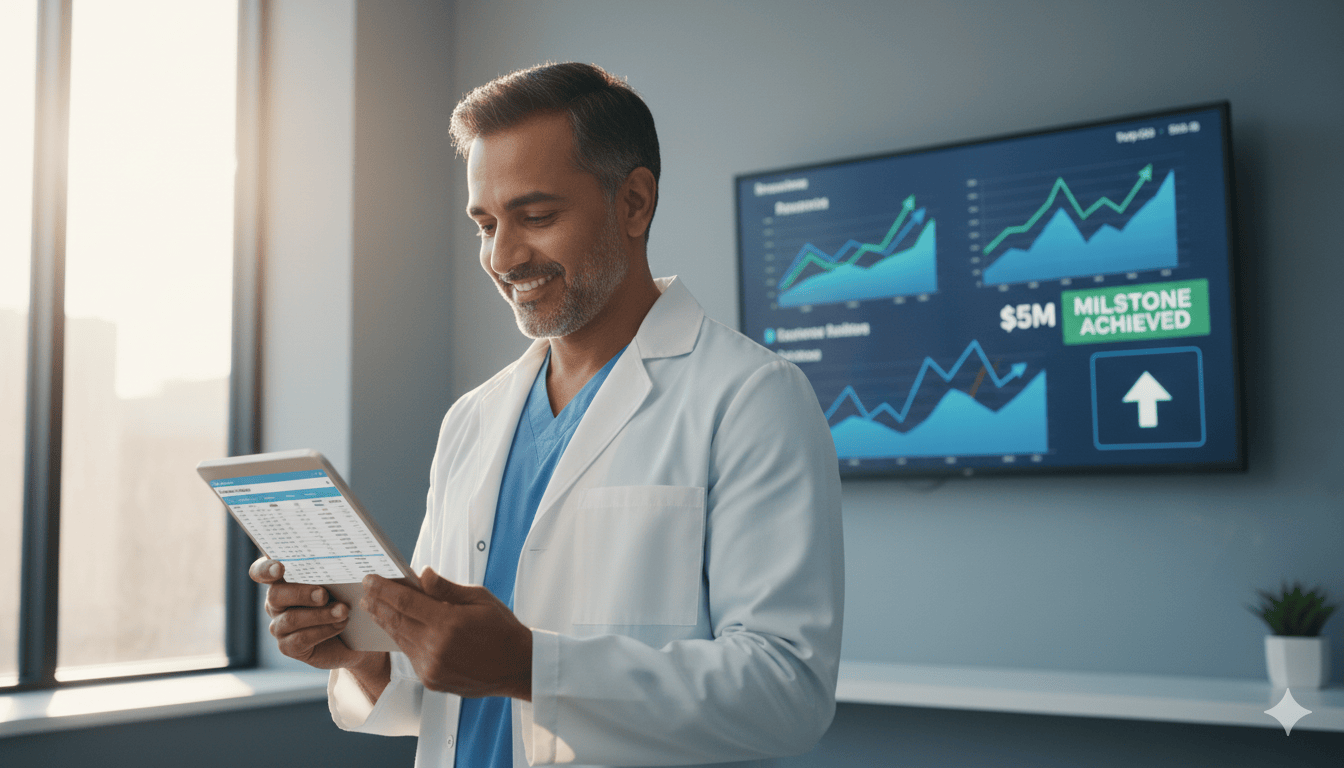Remote Patient Monitoring (RPM) and Remote Therapeutic Monitoring (RTM) represent two of the fastest-growing revenue opportunities for healthcare providers in 2025. These programs allow practices to monitor patients between office visits, improve chronic disease outcomes, and generate substantial recurring revenue—all while being reimbursed by Medicare and most commercial payers. But many providers remain confused about the differences between RPM and RTM, how to implement compliant programs, and what revenue they can realistically expect. This comprehensive guide answers all your questions.
RPM vs. RTM: Understanding the Critical Differences
Let's start by clearing up the confusion. RPM and RTM are related but distinct programs with different clinical applications, technology requirements, and billing rules.
Remote Patient Monitoring (RPM): Physiological Data Monitoring
RPM involves using connected devices to collect and transmit physiological health data from patients between clinical visits. Think of anything your body does automatically that can be measured: blood pressure, heart rate, blood glucose levels, weight, oxygen saturation, heart rhythm (ECG), respiratory rate, temperature. These are objective, measurable physiological parameters.
The key requirement: Data must be collected electronically from a medical device and transmitted automatically or manually to your practice. You can't just ask patients to write down their blood pressure in a journal—it must come from a digital device.
RPM CPT Codes: 99453 - Initial device setup and patient education (one-time per episode), 99454 - Device supply and data transmission (monthly, minimum 16 days of data), 99457 - First 20 minutes of interactive communication/clinical review (monthly), 99458 - Each additional 20 minutes of communication/review, 99091 - Collection and interpretation of physiological data (30-day period).
Typical RPM Applications: Hypertension monitoring (blood pressure), heart failure monitoring (weight, blood pressure, symptoms), diabetes management (blood glucose), COPD/asthma (pulse oximetry, peak flow), post-surgical monitoring, cardiac arrhythmia monitoring.
Remote Therapeutic Monitoring (RTM): Non-Physiological Data Monitoring
RTM, introduced more recently, focuses on monitoring non-physiological data related to therapeutic interventions. This includes things patients do intentionally as part of treatment: medication adherence, physical therapy exercises, respiratory therapy (spirometry, inhaler use), musculoskeletal therapy adherence, pain levels and functional status, cognitive or behavioral health monitoring.
The data is still collected electronically, but it's about patient behaviors, therapy compliance, and self-reported outcomes rather than automatic physiological measurements.
RTM CPT Codes: 98975 - Initial device setup and patient education (one-time per episode), 98976 - Device supply and data transmission (monthly, minimum 16 days of data), 98977 - First 20 minutes of treatment management services (monthly), 98980 - Respiratory system status monitoring (30-day period), 98981 - Musculoskeletal system status monitoring (30-day period).
Typical RTM Applications: Post-surgical rehabilitation adherence, medication adherence tracking, pain management monitoring, respiratory therapy for COPD/asthma, physical therapy exercise compliance, post-stroke rehabilitation monitoring.
Key Distinction: RPM measures what your body does automatically (heart rate, blood pressure). RTM measures what you do intentionally as treatment (exercises, medication-taking, therapy compliance). Both generate reimbursable revenue, but for different clinical scenarios.
Many practices implement both programs, using RPM for chronic disease management and RTM for rehabilitation and therapy monitoring. They're complementary, not competitive.
The Revenue Opportunity: What You Can Realistically Bill
Let's cut through the hype and look at realistic revenue numbers based on actual Medicare reimbursement rates and program requirements.
Medicare Reimbursement Rates (2025 National Average):
RPM: 99453 (setup) - $19.50, 99454 (device/transmission) - $65.00/month, 99457 (20 min review) - $52.00/month, 99458 (additional 20 min) - $42.00/month. RTM: 98975 (setup) - $19.50, 98976 (device/transmission) - $55.00/month, 98977 (20 min review) - $52.00/month.
Note: Commercial payer rates often 20-40% higher than Medicare. Geographic adjustments apply.
Average Revenue Per RPM/RTM Patient Per Month:
Conservative scenario (meeting minimum requirements): Device/transmission + first 20-min review = $117/month for RPM, $107/month for RTM.
Realistic scenario (includes some additional review time): Device/transmission + 20-40 min review = $159-$201/month for RPM.
Annual Revenue Potential for Your Practice:
Small practice (50 RPM patients): $70,000 - $120,000 annually. Medium practice (200 RPM patients): $280,000 - $480,000 annually. Large practice (500 RPM patients): $700,000 - $1,200,000 annually.
This is recurring revenue, month after month, as long as patients remain enrolled. Unlike one-time procedure revenue, RPM/RTM creates predictable monthly cash flow.
What About Program Costs? Device costs are typically $20-60 per patient per month (covered by 99454/98976 reimbursement). Platform/software fees range from $15-40 per patient per month. Staff time for clinical review is already reimbursed through 99457/98977 codes. Net margin after costs: typically 40-60% of gross revenue.
So that medium-sized practice generating $280K-$480K in RPM revenue has actual profit of $112K-$288K after expenses. That's the equivalent of hiring 2-5 additional physicians in terms of profit impact—without needing more exam rooms or support staff.
Commercial Payer Coverage: Most major commercial payers now reimburse for RPM/RTM, often at higher rates than Medicare. Blue Cross Blue Shield plans, UnitedHealthcare, Aetna, Cigna, and Humana all have established coverage policies. Always verify with specific payers in your area, but coverage is rapidly becoming universal.
Technology Requirements & Integration: What You Actually Need
One of the biggest barriers to RPM/RTM adoption is confusion about technology requirements. Let's demystify what you actually need.
1. Patient Monitoring Devices
For RPM, you need FDA-cleared medical devices that automatically collect and transmit physiological data. Common devices include: Bluetooth-enabled blood pressure monitors, cellular-connected weight scales, pulse oximeters with data transmission, continuous glucose monitors (CGMs), ECG monitors (wearable or mobile).
Key requirement: Devices must be provided to patients (you can't require them to buy their own), and they must transmit data electronically. Manual data entry by patients doesn't qualify for RPM billing.
For RTM, technology requirements are more flexible since you're monitoring patient actions rather than automatic physiological measurements. Solutions include: Mobile apps with therapy exercise tracking, smart inhalers that log usage, medication adherence apps, activity trackers for rehab, pain and symptom tracking platforms.
Device costs are reimbursed through CPT code 99454 (RPM) or 98976 (RTM), so while there's an upfront investment, it's covered by payer reimbursement over time.
2. Data Management Platform
You need a platform to receive device data, store it securely, analyze it for clinical alerts, and present it to your clinical team in an actionable format. Essential platform features include: Integration with multiple device manufacturers, HIPAA-compliant data storage and transmission, Configurable clinical alerts (e.g., alert if blood pressure >180/100), Patient communication tools (automated messages, video calls), Billing support (tracking time requirements, generating billing-ready reports), EHR integration (ideally bi-directional).
Many vendors offer turnkey RPM/RTM platforms that include devices, software, and support for a per-patient-per-month fee. This can be easier than piecing together separate device and software vendors.
3. EHR Integration Considerations
The best RPM/RTM programs integrate seamlessly with your existing EHR. What to look for: Automatic data flow from monitoring platform to EHR, eliminating duplicate documentation. Clinical alerts appearing in your normal workflow. Billing code suggestions based on documented activities. Patient eligibility identification (which patients qualify for RPM/RTM based on diagnoses).
Ask potential vendors: Which EHR systems do you integrate with? Is it a true API integration or just data export/import? Can providers review patient data without leaving the EHR? How are alerts presented to clinical staff?
Poor EHR integration is the #1 reason RPM/RTM programs fail. If your staff has to log into separate systems and manually transfer data, adoption will collapse. Insist on seamless integration.
4. Data Security and HIPAA Compliance
All RPM/RTM technology must be HIPAA-compliant. Verify that vendors have signed Business Associate Agreements (BAAs), maintain SOC 2 Type II or equivalent security certifications, encrypt data in transit and at rest, provide audit logs of all data access, and have incident response plans for potential breaches.
Don't compromise on security. A single HIPAA breach can cost far more than any revenue your program generates.
5. Patient Consent Workflows
Before enrolling patients in RPM/RTM, you must obtain informed consent. Your platform should include consent management features: Digital consent forms patients can sign electronically, Documentation of consent in patient record, Ability for patients to revoke consent at any time, HIPAA-compliant consent language.
Many practices integrate consent into their existing patient intake process, having patients sign RPM/RTM consent along with other practice forms.
Building Your RPM/RTM Program from Scratch: Step-by-Step Implementation
Ready to launch? Here's the practical roadmap from zero to operational RPM/RTM program.
Step 1: Define Your Clinical Focus
Don't try to monitor everything for everyone. Start focused. Identify your highest-impact conditions: Which chronic diseases do you treat most frequently? Where do you see the most preventable complications or hospitalizations? Which conditions have clear monitoring parameters?
Most practices start with 1-2 conditions: Hypertension (RPM with blood pressure monitoring) is often the easiest starting point—huge patient population, simple monitoring, clear clinical value. Heart failure (RPM with weight and BP monitoring) has high impact but requires more intensive monitoring. Diabetes (RPM with glucose monitoring) has good reimbursement but requires engaged patients.
Once you've proven success with your initial focus, expand to additional conditions.
Step 2: Establish Patient Eligibility Criteria
Not every patient with hypertension needs RPM. Define clear enrollment criteria: Clinical criteria (e.g., uncontrolled hypertension with BP >140/90, history of hypertensive emergency, multiple medication changes). Risk criteria (recent hospitalization, multiple comorbidities, high-risk medications). Patient engagement criteria (willing to use technology, reliable with appointments, motivated to improve health).
Create a simple screening process to identify eligible patients. Many practices flag eligible patients in their EHR and have MAs offer enrollment during regular office visits.
Step 3: Assign Staff Roles and Responsibilities
Who will do what in your RPM/RTM program? Typical roles include: Medical Assistant or RN: Patient enrollment and device training, initial device setup, handling patient questions about devices. Clinical staff (RN, NP, or physician): Reviewing monitoring data, responding to clinical alerts, interactive communication with patients (the 20-minute requirement), documentation in EHR, clinical decision-making. Billing staff: Tracking time requirements, submitting claims, following up on denials.
The key: The clinical review and communication (99457/98977) must be performed by a qualified healthcare professional (QHP) - physician, NP, PA, RN, or clinical staff working under their supervision. This ensures clinical appropriateness and meets billing requirements.
Time requirement: For a typical practice with 100 RPM patients, expect about 10-15 hours per week of clinical staff time for data review and patient communication. This is reimbursed at $52/hour through billing codes, so it's revenue-positive.
Step 4: Documentation Requirements (Critical for Compliant Billing)
RPM/RTM billing is time-based, which means you must document your time meticulously. Requirements for 99454/98976 (device/transmission): At least 16 days of data transmitted in a 30-day period. Document in patient record: dates of data transmission, type of data collected.
Requirements for 99457/98977 (clinical review): At least 20 minutes of interactive communication or clinical review in a 30-day period. Document in patient record: date and time of each interaction, duration of interaction, clinical issues discussed, any treatment changes made, clinical decision-making.
Best practice: Use time-tracking features in your RPM/RTM platform or EHR templates that automatically calculate accumulated time. Many platforms generate billing-ready reports showing which patients meet time requirements each month.
Step 5: Patient Enrollment and Training
How do you actually get patients enrolled? Successful practices use multiple enrollment pathways: In-office enrollment during regular visits (highest success rate). Targeted outreach to eligible patients via phone or patient portal. Enrollment at discharge from hospital (for heart failure, post-surgical patients). Referral from specialists who want ongoing monitoring.
Training process: Explain the program benefits to patient (better health outcomes, fewer office visits, proactive care). Obtain informed consent. Provide monitoring device and demonstrate how to use it. Have patient complete first measurement with staff present. Provide written instructions and support phone number. Schedule follow-up call to ensure patient is successfully using device.
Success factors: Keep it simple. Don't overwhelm patients with complex technology. Emphasize convenience and health benefits, not technology. Provide outstanding support during first 2 weeks—this is when most patients drop off. Celebrate early wins with patients (show them their improving blood pressure trends).
Step 6: Billing and Coding Best Practices
RPM/RTM billing is straightforward if you follow requirements precisely. Common billing mistakes to avoid: Billing without 16 days of data in the period. Billing without documenting 20 minutes of time. Billing for RPM and CCM (Chronic Care Management) in the same month without meeting separate time requirements. Billing for clinical staff time that doesn't meet QHP requirements. Not obtaining informed consent before billing.
Best practice: Use practice management software or billing services that specialize in RPM/RTM. They know the nuances and keep up with changing requirements.
Audit defense: Keep meticulous documentation. If audited, you must prove you met time and data transmission requirements. Good documentation makes this simple. Poor documentation can result in claim denials and refund demands.
Scaling Your Program for Maximum Impact: From 50 to 500+ Patients
Once you've proven success with your initial cohort, it's time to scale. Here's how practices grow from pilot programs to enterprise-scale operations.
Automating Patient Enrollment
Manual enrollment doesn't scale beyond 100-150 patients. Automation strategies include: EHR flags that automatically identify eligible patients. Patient portal invitations with digital enrollment forms. Automated phone outreach with enrollment scheduling. Post-visit follow-up emails with enrollment links.
The goal: Make enrollment frictionless. Every eligible patient should receive an invitation with minimal staff effort.
Using Data Analytics for Patient Selection
As you scale, prioritize enrollment based on who will benefit most and where you'll see highest ROI: Highest-risk patients (most likely to be hospitalized without monitoring). Patients in value-based contracts (where quality outcomes impact your payment). Patients with multiple chronic conditions (may qualify for both RPM and CCM). Patients who've expressed interest but haven't enrolled.
Advanced platforms use predictive analytics to identify which patients are most likely to engage successfully with RPM/RTM, improving enrollment efficiency.
Monitoring Compliance and Outcomes
Track key program metrics: Patient engagement rate (what % are transmitting data regularly?). Clinical outcomes (are monitored patients' vital signs improving?). Hospitalization rates (are you preventing acute events?). Revenue per patient per month. Program satisfaction (patient and provider feedback).
Use these metrics to continuously improve. If engagement drops after 90 days, implement re-engagement campaigns. If certain conditions have better outcomes than others, shift enrollment focus. If revenue per patient is below expectations, audit your billing processes for missed opportunities.
The Bottom Line: RPM/RTM Is No Longer Optional
Remote patient monitoring has evolved from experimental pilot programs to standard of care. Practices that successfully implement RPM/RTM programs see improved patient outcomes, reduced hospitalizations, increased patient satisfaction, substantial recurring revenue, and competitive advantages in value-based contracts.
The technology exists, the reimbursement is solid, and the clinical evidence is compelling. The only question is whether you'll implement now—or watch your competitors capture this revenue opportunity first.






.jpg)
.jpg)
